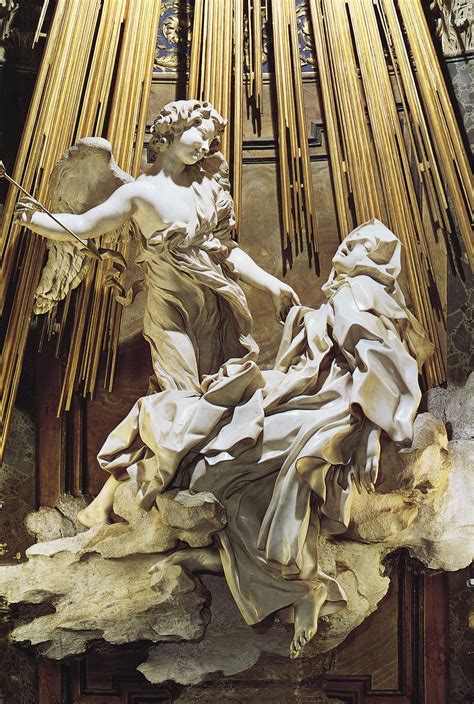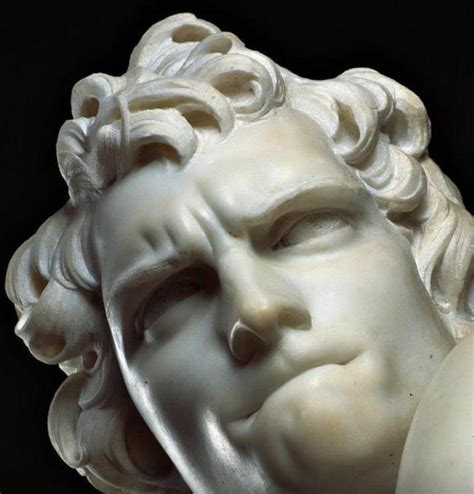Immerse yourself in the captivating world of one of the most brilliant minds of the Renaissance era. Explore the life and artistic achievements of Gian Lorenzo Bernini, a visionary sculptor whose works have left an indelible mark on the world of art. From his innovative approach to sculpture to his profound impact on the Baroque movement, Bernini's contributions continue to ignite the imagination of art lovers worldwide.
Discover the essence of Bernini's artistic genius as you delve into the intricacies of his sculptural masterpieces. With a remarkable ability to infuse life into stone, he effortlessly breathed soul and emotion into his creations. Each piece, meticulously crafted by Bernini's deft hands, exudes a remarkable sense of dynamic movement and tangible passion.
Unleashing the power of marble, Bernini's sculptures have the extraordinary ability to transcend time and space, allowing viewers to immerse themselves in the world of extraordinary beauty and raw human emotion. With an unwavering attention to detail and a profound understanding of human anatomy, Bernini presents his subjects with unparalleled realism and energy, capturing fleeting moments frozen in eternal stone.
Journey through the artist's masterworks, from the ethereal beauty of "Apollo and Daphne" to the dramatic intensity of "The Ecstasy of Saint Teresa." Each sculpture reveals Bernini's ability to express the deepest facets of human nature through art. Poised between the realms of reality and myth, his works invite contemplation and provoke profound emotions in those fortunate enough to witness them.
Step into the world of Gian Lorenzo Bernini, where beauty knows no boundaries and the human spirit is forever immortalized in marble. Embark on a captivating journey through history, exploring the life and transformative artistry of the extraordinary Renaissance sculptor whose impact continues to resonate to this day.
The Early Years: Bernini's Childhood and Artistic Journey

Let's delve into the formative years of one of history's most celebrated sculptors. This section explores the early experiences and artistic development of the illustrious Bernini, encompassing his childhood and the path that paved the way for his extraordinary talent.
1. A Promising Start: Born into an artistic family in 1598, Bernini showed an innate inclination towards creativity from a young age. Growing up amongst skillful artisans, he soaked in the sculpting techniques and absorbed the artistic atmosphere surrounding him.
2. Nurturing the Creative Spirit: As a child prodigy, Bernini's aptitude for sculpting flourished under the guidance of his father, Pietro Bernini, a distinguished sculptor himself. The elder Bernini recognized the potential in his son and provided him with comprehensive training and exposure to the intricacies of the craft.
3. Embracing Baroque Influences: During his formative years, Bernini encountered the flamboyant and dynamic style of the Baroque movement, which would later shape his own distinctive aesthetic. The exuberance, grandeur, and emotional intensity found in Baroque architecture and art captured his imagination and left an indelible mark on his artistic vision.
4. An Apprenticeship under the Masters: To further refine his skills, Bernini sought apprenticeships with established masters, such as his father and renowned sculptor Stefano Maderno. Under their mentorship, he honed his ability to manipulate marble with precision, creating astonishingly lifelike sculptures that would define his future oeuvre.
5. Breaking Conventional Boundaries: Even at a young age, Bernini displayed a relentless desire to innovate and push the boundaries of traditional sculpture. His early works showcased a remarkable ability to capture human emotions, infusing his creations with a sense of vitality and theatricality that set him apart from his contemporaries.
6. Recognition and Patronage: Bernini's remarkable talent quickly gained recognition and patronage from influential figures of the time, propelling his career to new heights. Noteworthy commissions during his early years included works for influential cardinals and powerful Roman families, solidifying his reputation as a master sculptor.
In this crucial stage of Bernini's life, his artistic journey took flight, laying the foundation for the extraordinary contributions he would make to the world of sculpture in the years to come.
A Closer Look at the Revolutionary Sculptural Style of Bernini
Exploring the artistic brilliance of Gian Lorenzo Bernini unveils a sculptural style that defied conventions and marked a groundbreaking departure from the norms of his time. This section delves deeper into the artistic techniques and characteristics that defined Bernini's revolutionary approach.
Innovative Expression: Bernini's sculptures exuded an unparalleled ability to capture motion, emotion, and the human essence. Through his mastery of form and composition, he breathed life into stone, revolutionizing the medium of sculpture. His works conveyed a palpable sense of realism and dynamism, pushing boundaries and inspiring awe in viewers.
Dramatic Narrative: Bernini's sculptural style transcended static representations by imbuing his works with captivating narratives. His figures reverberated with energy and emotion, often frozen in the midst of intense drama. By expertly employing symbolism and gestural elements, Bernini created mesmerizing compositions that invited viewers to immerse themselves in the unfolding story.
Pioneering Technique: Bernini embraced new technical advancements, allowing him to achieve sculptural feats previously thought impossible. His ability to carve intricate details, such as flowing fabric or delicate facial expressions, demonstrated his unparalleled skill. He also introduced innovative use of light and shadow, harnessing the play of sunlight to enhance the sculptural elements and create a sense of depth and three-dimensionality.
Expressive Mastery: Bernini's sculptures were marked by an acute attention to anatomical precision and meticulous craftsmanship. His ability to capture the complexities of human anatomy resulted in figures that appeared tangible and lifelike. By subtly manipulating form, expressing palpable emotions, and combining various textures, Bernini created sculptures that were not only visually striking but also emotionally evocative.
In conclusion, Bernini's revolutionary sculptural style defied the norms of his time, embracing innovation, narrative depth, technical prowess, and expressive mastery. His works continue to astound and inspire, cementing his place as one of the most influential sculptors in the history of art.
Success and Controversy: Bernini's Patronage and Public Reception

Exploring the legacy of Gian Lorenzo Bernini, this section delves into the remarkable success and controversial reception of his works as a sculptor during the Renaissance era. It examines the significant impact of his influential patrons on his career and the public's response to his groundbreaking art.
Patronage: A Powerful Influence
One cannot overstate the profound influence of Bernini's benefactors on his artistic trajectory. From powerful ecclesiastical figures to wealthy aristocrats, these patrons recognized Bernini's extraordinary talent and provided invaluable support throughout his career. Through their patronage, Bernini was able to bring his artistic visions to life, elevating his status and establishing his reputation as a master sculptor.
Controversy and Criticism
While Bernini enjoyed immense success, his innovative approach to sculpture also sparked controversy and criticism. Some conservative factions within the artistic community viewed his works as too bold and unconventional, challenging traditional aesthetics. However, amidst the controversy, Bernini's art captivated a broader audience, attracting admirers who embraced his avant-garde style.
A Public Fascinated
As Bernini's popularity grew, the public became increasingly intrigued by his sculptures. His ability to infuse emotion and movement into stone captivated viewers, eliciting a sense of wonder and awe. The public eagerly embraced his creations, celebrating his ability to transcend the limitations of the medium and create lifelike figures that seemed to breathe and interact with the space around them.
An Enduring Legacy
Bernini's patronage and public reception played a pivotal role in shaping his career and cementing his status as one of the greatest sculptors of his time. His ability to navigate controversy and capture the imagination of the public ensured his works would be admired for generations to come, leaving an indelible mark on the history of art.
Legacy and Influence: The Enduring Impact of Bernini on Art during the Renaissance Period
In this section, we delve into the remarkable influence and lasting legacy of one of the eminent figures of the Renaissance period, Gian Lorenzo Bernini. His indelible mark on art and sculpture shaped the course of Renaissance aesthetics, leaving a profound impact that resonates even today.
Revolutionizing Sculpture:
One cannot underestimate the revolutionary impact Bernini had on the art of sculpture during the Renaissance era. His innovative techniques and unparalleled craftsmanship breathed life into marble, transcending traditional static forms. Through his works, Bernini succeeded in instilling dynamic movement, emotional depth, and a sense of vitality previously unseen in sculpture.
Master of Drama and Emotion:
Bernini's skillful manipulation of form and mastery of expression elevated him to the status of a virtuoso artist. His sculptures feature dynamic gestures, intense facial expressions, and intricate details that evoke a profound emotional response from viewers. The ability to capture and convey a range of emotions truly distinguished Bernini from his contemporaries and solidified his place as a preeminent sculptor in the Renaissance period.
Architectural Integration:
Bernini's influence extended far beyond traditional sculpture as he seamlessly integrated his creations with architecture. His innovative approach to sculptural installations within architectural settings revolutionized the concept of spatial harmony and transformed monuments and spaces into immersive experiences. The incorporation of sculpture into the fabric of the environment allowed for a truly unified and harmonious artistic expression.
Celebrating Divine Beauty:
The spiritual and religious themes prevalent in Bernini's works conveyed not only a deep reverence for faith but also an appreciation for divine beauty. His sculptures, often depicting religious figures and scenes from biblical narratives, captured the essence of devotion and transcendence. Bernini's ability to imbue his subjects with a divine radiance and ethereal grace has left an indelible mark on religious art.
Continuing Influence:
Even centuries after Bernini's passing, his influence on art remains palpable. Countless sculptors and artists throughout the years have looked to his thoughts and techniques for inspiration and guidance. Bernini's enduring legacy continues to shape contemporary art, as his innovative spirit and unprecedented skill continue to inspire and captivate artists and audiences alike.
FAQ
Who was Gian Lorenzo Bernini?
Gian Lorenzo Bernini was an Italian artist, primarily known as a sculptor, during the Renaissance period. He was born in 1598 in Naples, Italy, and is considered one of the most important figures in the history of art.
What are some of Bernini's most famous masterpieces?
Bernini created numerous famous masterpieces, including the sculptures of David, Apollo and Daphne, and The Ecstasy of Saint Teresa. He also designed and executed the colonnade in St. Peter's Square in Rome, which is considered one of his greatest architectural achievements.
What influenced Bernini's style of sculpting?
Bernini was heavily influenced by the Baroque style, which was characterized by dramatic expressions, movement, and intense emotionalism. His sculptures often showcased these characteristics, as he aimed to evoke strong emotions in viewers through his art.
What was Bernini's personal life like?
Bernini had a complex personal life. He was married and had several children, but he also had numerous extramarital affairs, which caused scandal and controversy. Despite these personal challenges, he enjoyed great success and recognition for his artistic talent during his lifetime.
What is Bernini's legacy in the world of art?
Bernini's legacy in the world of art is immense. His innovative approach to sculpture and architecture helped shape the Baroque movement and influenced countless artists that followed him. His works continue to be celebrated and admired for their technical skill, emotional depth, and beauty.



